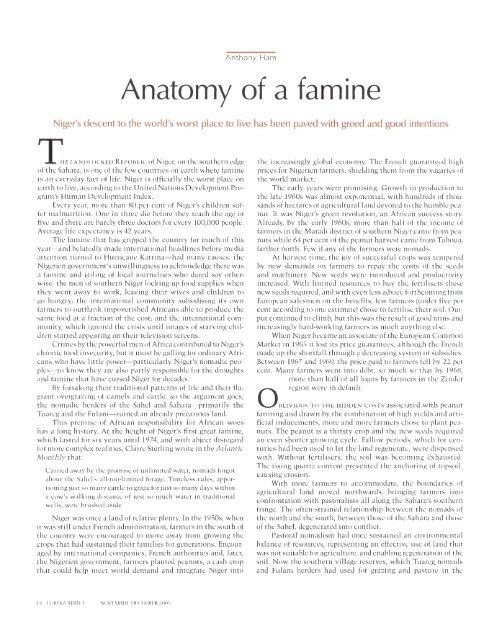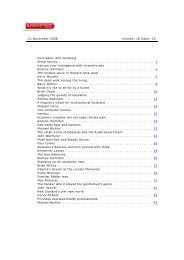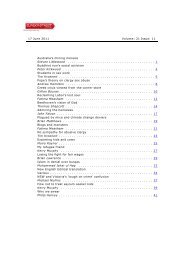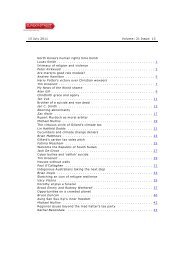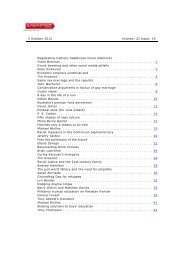0 - Eureka Street
0 - Eureka Street
0 - Eureka Street
You also want an ePaper? Increase the reach of your titles
YUMPU automatically turns print PDFs into web optimized ePapers that Google loves.
hunger: I<br />
Anthony Ham<br />
Anatomy of a famine<br />
Niger's descent to the world's worst place to live has been paved with greed and good intentions<br />
L , LANDLOCKED Roeu•uc of Nige>, on the 'oothem edge<br />
of the Sahara, is one of the few countries on earth where famine<br />
is an everyday fact of life. Niger is officially the worst place on<br />
earth to live, according to the United Nations Development Program's<br />
Human Development Index.<br />
Every year, more than 80 per cent of Niger's children suffer<br />
malnutrition. One in three die before they reach the age of<br />
five and there are barely three doctors for every 100,000 people.<br />
Average life expectancy is 42 years.<br />
The famine that has gripped the country for much of this<br />
year-and belatedly made international headlines before media<br />
attention turned to Hurricane Katrina-had many causes: the<br />
Nigerien government's unwillingness to acknowledge there was<br />
a famine and jailing of local journalists who dared say otherw<br />
ise; the men of southern Niger locking up food supplies when<br />
they went away to work, leaving their wives and children to<br />
go hungry; the international community subsidising its own<br />
farmers to outflank impoverished Africans able to produce the<br />
same foo d at a fraction of the cost; and the international community,<br />
which ignored the crisis until images of starving children<br />
started appearing on their television screens.<br />
Crimes by the powerful men of Africa contributed to Niger's<br />
chronic food insecurity, but it must be galling for ordinary Africans<br />
who have little power- particularly Niger's nomadic peoples-to<br />
know they are also partly responsible for the droughts<br />
and famine that have cursed Niger for decades.<br />
By forsaking their traditional patterns of life and their flagrant<br />
overgrazing of camels and cattle, so the argument goes,<br />
the nomadic herders of the Sahel and Sahara-primarily the<br />
Tuareg and the Fulani- ruined an already precarious land.<br />
This premise of African responsibility for African woes<br />
has a long history. At the height of Niger's first great famine,<br />
which lasted for six years until 1974, and with abject disregard<br />
for more complex realities, Claire Sterling wrote in the Atlantic<br />
Monthly that:<br />
Carried away by the promise of unlimited water, nomads forgot<br />
about the Sahel's all-too-limited forage. Timeless rules, apportioning<br />
just so m any cattle to graze for just so many days within<br />
a cow's walking distance of just so much water in traditional<br />
well s, were brushed aside.<br />
Niger was once a land of relative plenty. In the 1950s, when<br />
it was still under French administration, farmers in the south of<br />
the country were encouraged to move away from growing the<br />
crops that had sustained their families for generations. Encouraged<br />
by international companies, French authorities and, later,<br />
the Nigerien government, farmers planted peanuts, a cash crop<br />
that could help meet world demand and integrate Niger into<br />
the increasingly global econom y. The French guaranteed high<br />
prices for Nigerien farmers, shielding them from the vagaries of<br />
the world m arket.<br />
The early years were promising. Growth in production to<br />
the late 1960s was almost exponential, with hundreds of thousands<br />
of hectares of agricultural land devoted to the humble peanut.<br />
It was Niger's green revolution, an African success story.<br />
Already, by the early 1960s, more than half of the income of<br />
fa rmers in the Maradi district of southern Niger came from peanuts<br />
while 64 per cent of the peanut harvest came from Tahoua,<br />
farther north. Few if any of the farmers were nomads.<br />
At harvest time, the joy of successful crops was tempered<br />
by new dem ands on farmers to repay the costs of the seeds<br />
and machinery. New seeds were introduced and productivity<br />
increased. With limited resources to buy the fe rtilisers these<br />
new seeds required, and with even less advice forthcoming from<br />
European salesmen on the benefits, few fa rmers [under five per<br />
cent according to one estimate) chose to fertllise their soil. Output<br />
continued to climb, but this was the result of good rains and<br />
increasingly hard-working farmers as much anything else.<br />
When Niger became an associate of the European Common<br />
Market in 1965 it lost its price guarantees, although the French<br />
made up the shortfall through a decreasing system of subsidies.<br />
Between 1967 and 1969, the price paid to farmers fell by 22 per<br />
cent. Many farmers went into debt, so much so that by 1968,<br />
more tha n half of all loans by farmers in the Zinder<br />
region were in default.<br />
0<br />
BLIVIOUS TO THE HIDDEN OSTS associated with peanut<br />
farming and drawn by the combination of h igh yields and artificial<br />
inducements, more and more farmers chose to plant peanuts.<br />
The peanut is a thirsty crop and the new seeds required<br />
an even shorter growing cycle. Fallow periods, which for centuries<br />
had been used to let the land regenerate, were dispensed<br />
with. Without fertilisers, the soil was becoming exhausted.<br />
The rising quartz content prevented the anchoring of topsoil,<br />
causing erosion.<br />
With more farmers to accommodate, the boundaries of<br />
agricultural land moved northwards, bringing farmers into<br />
confrontation with pastoralists all along the Sa hara's southern<br />
fringe. The often-strained relationship between the nomads of<br />
the north and the south, between those of the Sahara and those<br />
of the Sahel, degenerated into conflict.<br />
Pastoral nomadism had once sustained an environmental<br />
balance of resources, representing an effective usc of land that<br />
was not suitable for agriculture, and enabling regeneration of the<br />
soil. Now the southern village reserves, which Tuareg nomads<br />
and Fulani herders had used for grazing and pasture in the<br />
14 EUREKA STREET NOVEMBER- DECEMBER 2005


